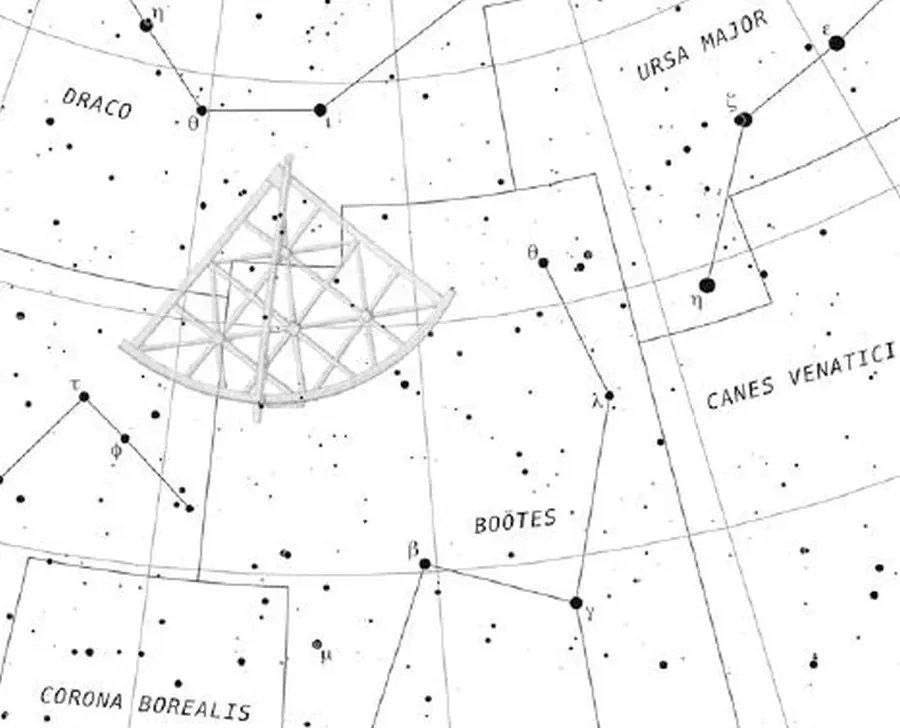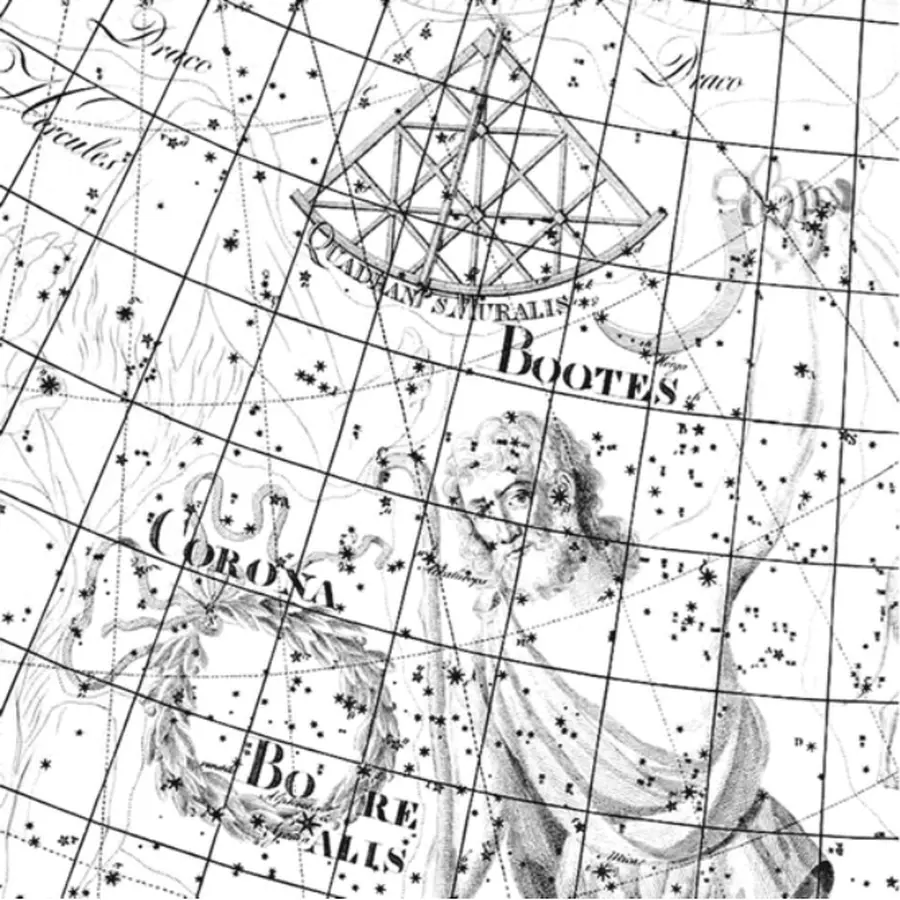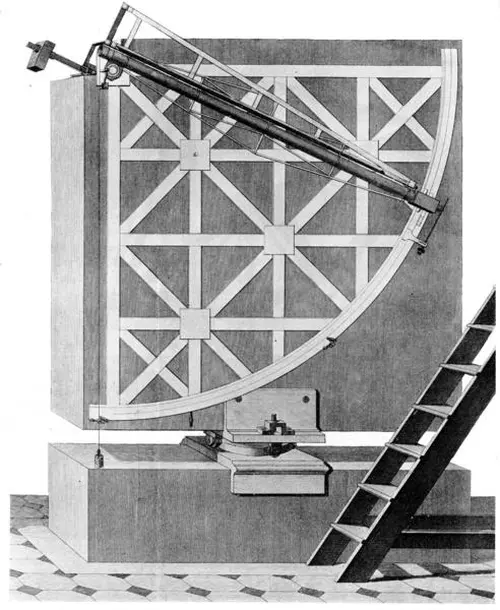Quadrans Muralis was a constellation created by the French astronomer Jérôme Lalande in 1795. It represented the mural quadrant, a large, wall-mounted angle measuring instrument that was widely used in positional astronomy in the 18th century. The constellation fell into disuse by the late 19th century.
Quadrans Muralis was located in the northern celestial hemisphere. It occupied a region of the sky in the northern part of Boötes (the Herdsman) and included a portion of Draco (the Dragon), near the handle of the Big Dipper in Ursa Major (the Great Bear). Because it was in a relatively faint patch of the sky, the constellation never stood out to observers. Its faintness ultimately led to it obscurity.
Quadrans Muralis is one of the best-known lost constellations. The constellation’s name is remembered in the Quadrantid meteor shower, an annual meteor shower that peaks in early January.

Quadrans Muralis (Le Mural) in Fortin’s 1795 edition of Flamsteed’s celestial atlas (PD)
The radiant of the Quadrantid meteors lies near the northern border of Boötes, between the tip of the Great Bear’s tail and the head of Draco. The meteor shower was discovered by Antonio Brucalassi in Italy in early January 1825 and identified as an annual event by the Belgian-French astronomer Adolphe Quetelet of the Brussels Observatory and American scientist Edward C. Herrick in 1839.
Jérôme Lalande originally named the newly invented constellation Le Mural. The astronomer used a mural quadrant himself to chart the celestial sphere with his nephew, the astronomer Michel Lefrançois de Lalande.
Lalande was not the first astronomer to name a constellation after a scientific instrument. He followed in the footsteps of his countryman Nicolas-Louis de Lacaille, who created 14 constellations in the far southern sky while charting the southern celestial hemisphere from the Cape of Good Hope in South Africa from 1750 to 1754.
Most of Lacaille’s constellations are named after instruments. They include Telescopium (the Telescope), Microscopium (the Microscope), Pyxis (the Mariner’s Compass), Octans (the Octant), Antlia (the Air Pump), and Horologium (the Pendulum Clock). The naming of constellations after instruments reflected the rapid evolution of astronomy from celestial mythology to an exact science.
Le Mural first appeared in French astronomer Jean-Baptiste Fortin’s Atlas Céleste of 1795. The sky atlas was first published in 1776, and Lalande and his colleague Pierre Méchain edited the revised version published in 1795. In the text accompanying the atlas, Fortin argued that the new constellation was justified in the tradition of naming constellations after scientific instruments introduced by Lacaille several decades earlier. He wrote:
“THE MURAL, or Mural Quadrant (plate 2), is yet a new constellation that the citizen Lalande placed in the empty space between the Dragon, the Herdsman and Hercules. Lacaille, after observing the southern stars, formed new constellations out of instruments of the arts and sciences (Mémoires 1752). By his example, we thought to devote [space] in the northern hemisphere to the costly instrument used in the observations of 30,000 stars, that is to say the greatest monument of astronomy; and future astronomers, taking advantage of this tremendous work, without a doubt will retain this constellation of their own to recall its memory. All of these new constellations add even greater value to our atlas.”

The position of Quadrans Muralis on a modern map, image credit: Wikimedia Commons/Ultima Thulean (CC BY-SA 4.0)
Quadrans Muralis contained relatively faint stars between Nekkar (Beta Boötis), the star that marks the top of the Kite in Boötes, and Alkaid (Eta Ursae Majoris), the star at the tip of the Great Bear’s tail.
Lalande included 10 stars belonging to the new constellation in his table of circumpolar stars published in the Connaissance des temps in 1796. He explained that he had created the constellation to commemorate the instrument he had used to catalogue tens of thousands of stars at the École Militaire observatory in Paris.
The brightest star in Quadrans Muralis was 44 Boötis (mag. 4.70 – 4.84), a triple star system located 41.6 light-years away. In 2025, the International Astronomical Union (IAU) officially approved the name Quadrans for the brightest component in the system, a yellow dwarf. The system also contains a low-mass contact binary star classified as a W Ursae Majoris variable.
German astronomer Johann Elert Bode was the first to use the Latin name Quadrans Muralis for the constellation. He Latinized the name when he included the constellation in his star atlas Uranographia of 1801.

Quadrans Muralis shown on Plate 7 of Johann Elert Bode’s Uranographia (1801) (PD)
Bode also reduced the area of the sky of the constellation, adjusting its boundaries to avoid overlap with the existing constellations. In his version of Quadrans Muralis, the brightest star was CL Draconis, a magnitude 4.96 variable F-type subgiant located 109 light years away in what is now Draco. The star was moved back to its place in Draco when the IAU established the constellation boundaries in the early 20th century.
Other stars in Quadrans Muralis included the variable Ap star BP Boötis (mag. 5.48) and the triple star 39 Boötis (mag. 5.68).
Quadrans Muralis is one of the several obsolete constellations introduced by Lalande. Others included Felis (the Cat), Custos Messium (the Vineyard Keeper), and Globus Aerostaticus (the Hot Air Balloon). Lalande also created Officina Typographica (the Printing Office) with Johann Bode to commemorate the printing press invented by Johannes Gutenberg.

VII. Boötes et Mons Maenalus from *Coelum Stellatum* by Johann Elert Bode, published in 1801, depicts the constellation Boötes and the obsolete constellation Mount Maenalus. (PD)
Mural quadrant
The mural quadrant is a device used for measuring the elevation angles of stars and other astronomical objects. Before the invention of modern telescopes, it was an indispensable tool, one that allowed astronomers to measure the altitude of stars as they crossed the local meridian.
The mural quadrant is one of the simplest tools used to make measurements in positional astronomy. It consists of a quarter of a circular disk, with an outer edge that has a 90-degree angle, and a plumb line suspended from the point of the angle. The plumb line can be used to find the elevation of the Sun, Moon, stars, and other objects above the horizon.
The Greek astronomer Claudius Ptolemy is usually attributed for the invention of the quadrant. Ptolemy used a simple device that was an improvement on the astrolabe. However, similar devices were probably used by mariners for navigation at sea long before Ptolemy.

Mural Quadrant by Bird c. 1770, credit: J. A. Repsold, Geschichte der Astron. Messwerkzeuge, 1907 (PD)
Lalande may have chosen to honour the mural quadrant because the instrument played a crucial role in the formulation of Johannes Kepler’s laws of planetary motion in the early 17th century. Kepler defined his first two laws after analyzing the observations made by the Danish astronomer Tycho Brahe, who used a large brass mural quadrant installed at Uraniborg. Uraniborg was the first custom-built observatory in Europe and the last to be built without a telescope as the primary instrument.
While Quadrans Muralis was in wide use in the first half of the 19th century, some astronomers did not find it useful because of the absence of conspicuous stars. Additionally, the large number of new constellations created from the 17th to 19th century led to confusion, with many constellations overlapping or considered redundant.
Even though it gained popularity after its depiction in Uranographia, Quadrans Muralis largely fell into disuse a century later. American naturalist Richard Hinckley Allen noted that the constellation was “not recognized by modern astronomers” in his book Star Tales: Their Lore and Meaning (1899). By that time, the mural quadrant itself was replaced by telescopes and photographic equipment.
When the International Astronomical Union (IAU) agreed upon a list of 88 modern constellations at its first general assembly in Rome in May 1922, Quadrans Muralis was not included. The IAU officially adopted the list in 1930.
Even though the constellation was erased from official star maps over a century ago, the annual meteor shower has retained the name Quadrantids (QUA). The stars of Quadrans Muralis were reassigned to the more established constellations Boötes and Draco.

“Boötes, Canes Venatici, Coma Berenices, and Quadrans Muralis”, plate 10 in Urania’s Mirror, a set of celestial cards accompanied by A familiar treatise on astronomy… by Jehoshaphat Aspin. London. Astronomical chart, 1 print on layered paper board: etching, hand-colored (1825). (PD)